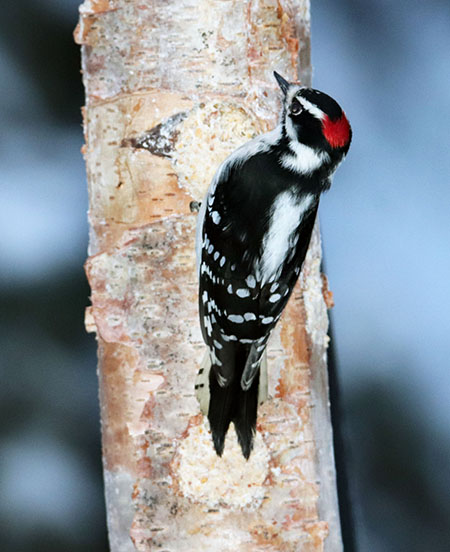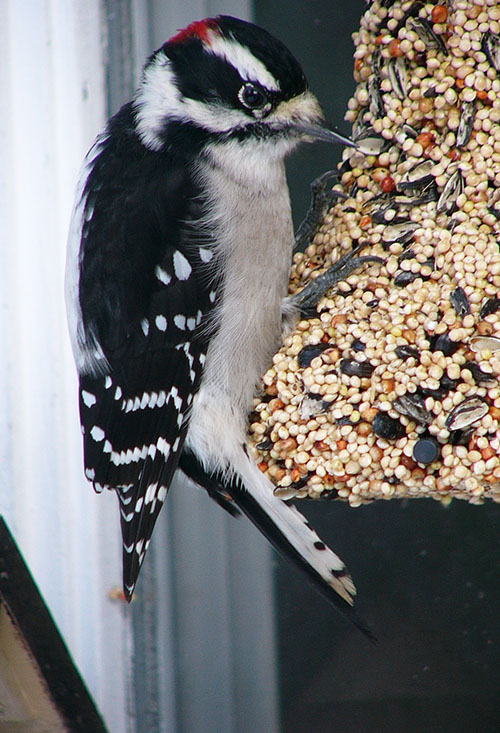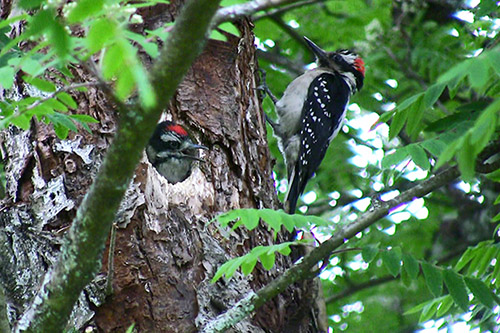Alaska Fish & Wildlife News
December 2023
Downy and Hairy Woodpeckers

Downy and Hairy woodpeckers are among my favorite visitors to the bird feeder. Their distinct black-and-white plumage and dappling was always a gorgeous sight, usually accompanied by their tweek-tweek-tweek call. In particular, a parent and grown nestling were visiting regularly. I say grown nestling, because for a teenager, that bird was hefty; the parents – both a female and male would rotate roles – would be barely clinging to the bird feeder while frantically feeding a voraciously hungry woodpecker not much smaller than themselves. In fact, I would say that the younger one was slightly larger than the adult bird was. I would imagine other parents may find this a familiar scenario.
Downy and Hairy woodpeckers are widespread in Alaska and found in Southeast, Southcentral and Interior Alaska. The smaller Downy woodpecker ranges a bit further west and Hairy woodpecker a bit further north. The Hairy woodpecker is the most widely distributed woodpecker in North America (along with the Northern flicker) and may be in almost any forest.
Spot the Difference (Literally)
Downy and Hairy Woodpeckers often exist in the same habitat, favoring mature forests, woodlots, parks, forest edges, and your back yard. Downy Woodpeckers tend to favor open woodlands more, especially deciduous trees; Hairy Woodpeckers are one of the woodpecker species drawn to burned areas. Although they are not closely related, they look quite similar - black and white birds with black wings pebbled with white spots patterned in horizontal lines. In both species, males are distinguished from females by the bright red patch on the back of their heads, called an occipital patch. So how do you tell the difference between these two birds that look similar and are found in the same places?
The most marked difference is their size; Downy Woodpeckers are distinctly smaller (in fact, the Downy woodpecker is the smallest woodpecker in North America), about seven inches long, the size of a golden-crowned sparrow and weighing about an ounce. Hairy Woodpeckers are closer to 10 inches long, the size of a robin and more than twice the weight of the Downy. The other major difference is their bills; a Hairy Woodpecker’s bill is long - about as long as its head, while a Downy Woodpecker’s is distinctly shorter, less than half the width of its head.
Other differences are more nuanced. The Hairy Woodpecker’s outer tail feathers are entirely white, the Downy woodpecker’s outer tail feathers are spotted with black. The “eyebrow” stripe that arcs over the eyes is called a nuchal bar, and on the female Downy, it goes around the head and connects at the back. On a female Hairy Woodpecker, the stripe or bar does not go around and is divided by black feathers. On the Hairy, the male’s red patch is often divided by a black line of feathers.

You may be well familiar with their distinctive calls already, a tweek-tweek-tweek. A Downy’s is pitched higher, and a faster, sharper, pik-pik-pik, where the Hairy’s is a little louder, peek-peek peek. This call is one of my favorites because as they’re in flight, following the unique rising and dipping pattern, they seem to announce themselves: tweek-tweek-tweek.
What’s in a Name?
The names reference a subtle difference in their similar appearance. “Downy” in the Downy name is for the soft white feathers of the white lower back, while Hairy’s feathers are– you guessed it– more hairlike. The birds were named by the British naturalist Mark Catesby, who studied the flora and fauna of the “New World” in the 1720s, based out of what’s now South Carolina. He described the woodpeckers in his book, Natural History of Carolina, Florida and the Bahama Islands, the first published account of the flora and fauna of North America. He must have handled the woodpeckers to consider that distinction noteworthy - while the white patch on the back of the birds is readily apparent, the subtle textures of the lower white feathers is not.
Disguises and Dominance
You’d expect birds that look almost identical to have a relatively recent common ancestor and shared evolutionary history, but that isn’t the case. Despite their close resemblance, Downy and Hairy woodpeckers are not closely related as woodpeckers go. Each species is more closely related to a very different looking group of woodpeckers. Hairy woodpeckers are more closely related to white-headed woodpeckers than to Downy woodpeckers; Downy woodpeckers are more closely related to Nuttall’s and ladder-backed woodpeckers.
So why would different looking species come to look similar? Yale University professor of ornithology Richard Prum proposed that by resembling the bigger and more powerful Hairy Woodpecker, the Downy reduces the chance of an attack by a Hairy Woodpecker. It’s known that many birds have difficulty discerning size differences at a distance of more than a few meters (hence the use of giant duck and goose decoys). This means that a Hairy Woodpecker approaching a Downy Woodpecker may easily mistake it for another Hairy Woodpecker because the one distinguishing feature – size – is imperceptible at distance. This mimicry and resemblance between not-very-closely related birds is documented with other species, such as greater and lesser yellowlegs.

The birds share a look that’s fairly striking to human eyes, but it serves them well in the forest. Princeton University senior Joe Kawalec proposed for a thesis project that the Downy woodpecker’s plumage has a dual function: they might be conspicuous when viewed up close but camouflaged at a distance to avoid being detected in the first place. Just as the striped vertical patterning of a zebra breaks up its outline (known as disruptive coloration), Downy woodpeckers hide in plain sight. At distance, the black-and-white patterning mimics tree bark and dappling from sunlight through the leafy canopy. Up close, it’s much more evident– and may serve to ward off rivals and predators mistaking them for more powerful Hairy woodpeckers.
Built with Purpose
Downy and Hairy Woodpeckers share similar food preferences, and their size difference influences their foraging. Downy Woodpeckers, being small and acrobatic, tend to seek food over tree branches and out to the tips, and closer to the ground; Hairy Woodpeckers trend higher on the trunk and on larger branches. Downy Woodpeckers are able to extract prey from the stems of weeds. Like most woodpeckers, they eat the larvae of wood-boring beetles, bark beetles and other insects, ants, and caterpillars. With their long, barbed tongues, and sticky, glue-like saliva, insects make an easy meal for these wonderful birds. They are not strict insectivores - around 25% of Downy woodpecker diets include plant material such as berries, acorns, and grains; for Hairy woodpeckers, around 20% is made up of fruits and seeds. Both species come to bird feeders for suet, peanut butter and sunflower seeds, but Downy woodpeckers tend to be more tolerant of people.
Their powerful bills are composed of strong bone overlaid with a hard covering of keratin, the same material that makes up our fingernails. The bone distributes the force of their pecking and drumming, and their brain does not suffer the impact as ours might if we tried to do the same thing. Fine feather “hairs” protect their nostril cavities from flying debris while hammering. While they’re drumming, they close their eyes prior to impact– protecting themselves from flying debris.

They anchor themselves to a tree by their feet, which have two toes in the front and two in the back. They wedge their straight, stiff, and flexible tailfeathers against the tree bark and fan them out for better support. This is all supported by their wide pelvic bones, allowing for muscles that have the strength to hold the tail in place. The holes woodpeckers make also serve other species such as owls looking for nesting or resting sites.
The loud drumming you might hear is an audio broadcast, the woodpecker’s version of a song, as their hammering for food tends to be much quieter. Hairy woodpeckers drumming is faster than a Downy – if you’re able to compare them. Both the males and females drum to advertise their presence and claim territorial rights. Recent studies have shown that their brains light up much in the same way that songbirds do, so they may learn drumming patterns in the same way. Nature’s band really isn’t complete without a drummer providing rhythm.
More about Downy and Hairy Woodpeckers
Sounds Wild! Woodpecker features
Feeding birds in Fall and Winter
Why are Hairy Woodpeckers and Downy Woodpeckers so hard to tell apart?
(Vermont Center for Ecostudies December 18, 2017 by Jon Lloyd)
The ‘Hidden’ Life of an Ecosystem Engineer
(Morgan Kelly, High Meadows Environmental Institute, June 1, 2021)
Subscribe to be notified about new issues
Receive a monthly notice about new issues and articles.
